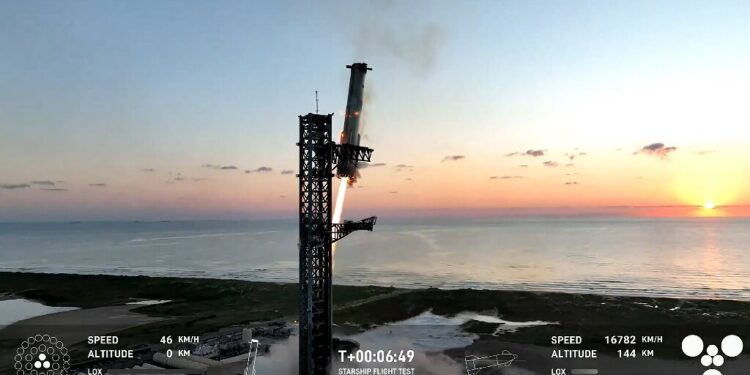This still image from a SpaceX broadcast shows Starship’s Super Heavy Booster “caught” in mid-flight as it returns to the launch pad near Boca Chica, Texas.
SpaceX managed to “catch” the first stage booster of its Starship megarocket on Sunday as it returned to the launch pad after a test flight, a world first in the company’s quest for rapid reusability.
The “super heavy booster” had taken off attached to the Starship rocket a few minutes earlier, then made a perfectly controlled return to the same platform in Texas, where a pair of enormous mechanical “wands” protruded from the launch tower to bring The booster descends slowly until it stops, according to a livestream from Elon Musk’s company SpaceX.
“Folks, this is a day for the engineering history books,” a SpaceX spokesperson said in a voiceover on the company’s livestream, after the booster was safely released within range of the tower and the company staff burst into joy.
“The tower caught the rocket!!” SpaceX founder Musk posted on X.
Takeoff took place at 7:25 a.m. (12:25 p.m. GMT) in clear weather. As the booster returned to the launch pad, the Starship’s upper stage was expected to crash into the Indian Ocean within the hour.
On its last flight in June, SpaceX made its first successful water landing with Starship, a prototype spacecraft that Musk hopes will one day carry humans to Mars.
NASA is also looking forward to a modified version of Starship that would serve as a landing vehicle for crewed flights to the Moon under the Artemis program later this decade.
SpaceX’s spacecraft is 400 feet tall with both floors combined, about 90 feet taller than the Statue of Liberty.
SpaceX said its engineers “spent years preparing and months testing the booster capture attempt, with technicians devoting tens of thousands of hours building the infrastructure to maximize our chances of success.”
Teams were monitoring to ensure “thousands” of criteria were met both on the vehicle and at the tower before any attempt was made to return the Super Heavy booster.
If the conditions had not been met, the booster would have been redirected to land in the Gulf of Mexico, as in previous tests.
Instead, after receiving the go-ahead, the returning booster decelerated from supersonic speeds and the powerful “wand arms” embraced it.
“Fail fast, learn fast”
The large mechanical arms, called “Mechazilla” by Musk, have generated considerable enthusiasm among space enthusiasts.
Starship is 400 feet tall with both stories combined, about 90 feet taller than the Statue of Liberty.
The SpaceX Starship sits on a launch pad at Starbase near Boca Chica, Texas, ahead of the Starship Flight 5 test.
Its Super Heavy booster, measuring 233 feet tall, produces 16.7 million pounds (74.3 meganewtons) of thrust, about twice as powerful as the Saturn V rockets used on the Apollo missions.
SpaceX’s rapid iterative testing strategy, “fail fast, learn fast,” even when its rockets explode spectacularly, ultimately accelerated development and contributed to the company’s success.
Founded only in 2002, it quickly outpaced the giants of the aerospace industry and is today the world leader in orbital launches, in addition to providing the only American spacecraft currently certified to carry astronauts.
It also created the world’s largest constellation of Internet satellites, an invaluable asset in disaster and war zones.
But his founding vision of making humanity a multi-planetary species increasingly risks being eclipsed by Musk’s embrace of Republican presidential candidate Donald Trump and his alignment with right-wing politics.
In recent weeks, the company has openly feuded with the Federal Aviation Administration over launch licenses and alleged violations, with Musk accusing the agency of going too far and calling for the resignation of its chief, Michael Whitaker.
“He’s trying to position himself for minimal regulatory interference with SpaceX once Donald Trump becomes president,” said Mark Hass, a marketing expert and professor at Arizona State University. “But if things go the other way, it’s a calculated gamble.”
© 2024 AFP
Quote: In a first, the booster of the Starship megarocket captured by SpaceX’s “wands” (October 13, 2024) recovered on October 13, 2024 on
This document is subject to copyright. Except for fair use for private study or research purposes, no part may be reproduced without written permission. The content is provided for informational purposes only.



